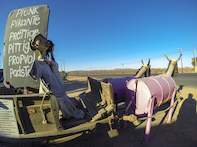Town on The Kokerboom Food and Wine Route
The town of Kakamas in the Northern Cape is worth a visit, especially when embarking on the Kokerboom Food and Wine Route.

Kakamas developed as a town between the late 1800s and early 1900s. It was a time of war and world depression and the bitterly poor people from the surrounding areas came to the church in Kakamas for help. They were offered the option to trade their labour for food. Canals had already been built in the near-by town of Upington and a similar project was proposed for Kakamas. It was found that, at Neusberg (meaning ‘Nose Mountain’, as it resembles a nose) about 10km from Kakamas, the river’s course was such that, if a canal were built, the water would flow automatically, doing away with the need for pumps.
Work began on the furrows – men, women and children dug relentlessly, manually. Often, the people would work at night to escape the intense heat of the day. Two canals or furrows were eventually completed, called the South and the North canals. During construction of the North canal, however, it became obvious that two tunnels would have to be built to maintain a gradient that facilitated the automatic water flow. Japie Lütz, from Upington, did the calculations and laid down the necessary measurements.
Eventually, the two tunnels were completed. Amazingly, they were both excavated from either side and met precisely – an impressive feat given it was achieved without the use of modern equipment. These hand-dug tunnels, one of them an impressive 160m long, are still in use and have been declared national monuments. A small settlement in the area, Lutzburg, is named after the self-trained engineer who designed the tunnels.
Canals Lead to Farming in Kakamas
Once the canals and tunnels had been constructed, it was possible for the people to begin farming. A number of water wheels (some still in use today) were built to lift the water from the canals into pipes for distribution into the fields. The community began planting food crops, and then expanded operations to include grapes. Originally it was mainly raisin grapes being produced in the area, but these days the area is renowned for its seedless table grapes and its wines. Because it is so warm in the area, the grapes ripen early and the crops can receive good prices in northern-hemisphere markets.
In the 1960s, the state took over the control of the canals from the church. The land was divided and private people could acquire it. The first hydroelectric scheme in South Africa was also started in Kakamas – at a place where the North canal dropped rapidly in elevation. This hydroelectric station is no-longer working, but the building at the scheme and the Egyptian-style transformer building in Kakamas town can still be visited. The two canals were eventually lined with cement in the 1990’s.
Historical Places to Visit in The Area

The old Egyptian-style transformer building in Kakamas; the hand-dug tunnels and canals and the water wheels are worth a visit.
The German graves dating back to the 1st World War. South Africa had been asked by the Allied Forces to occupy the mainly German South West Africa (now Namibia) and cut off the Germans from the sea. In February 1915, a group of German soldiers came through the Kakamas area from the north in an attempt to stake a claim on the river crossing nearby. Unfortunately for them, their recognisance information was incorrect and they were unaware of the approximately 2000 South African troops waiting for them.
In the resulting battle, eight Germans were killed. Documents recording the events claim that one of the eight shot himself as he was unable to drag his wounded body through the harsh heat to reach the river. The men were buried in shallow graves where they lay for many years. In 1964, the bodies were exhumed and some returned to Germany. The others were reburied just outside the town on the hill where they had fought and a monument erected in their memory.
Many visitors find the marks left by the devastating floods of 1974 and 1988 particularly intriguing. These floods occurred when it rained excessively in the Maluti and Drakensberg Mountains in the east and both the Vaal and Gariep Dams upstream overflowed. Inhabitants tell sad tales of the fruit trees being swept away and many orchards being decimated. The footbridge crossing the river above the Augrabies Falls was destroyed by floodwater and has not been re-built; and
The Pienk Padstal which houses a flood-level marker and photographs of the floods.
 The Kokerboom Food and Wine Route embraces the towns and settlements of Keimoes, Kanoneiland, Kenhardt, Augrabies, Upington and Marchand. Th...
The Kokerboom Food and Wine Route embraces the towns and settlements of Keimoes, Kanoneiland, Kenhardt, Augrabies, Upington and Marchand. Th...